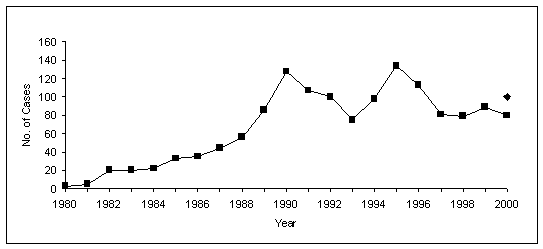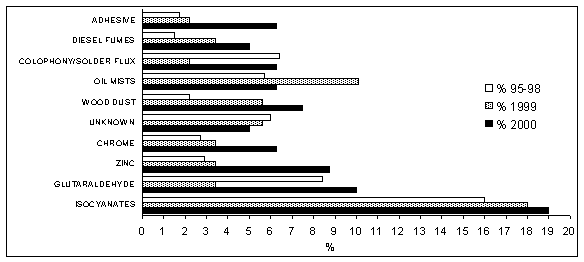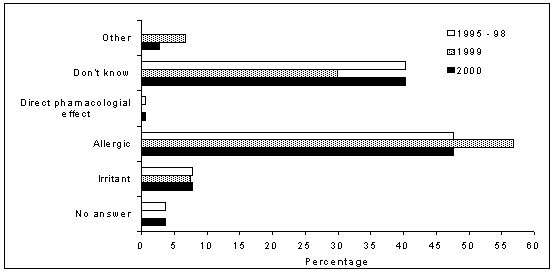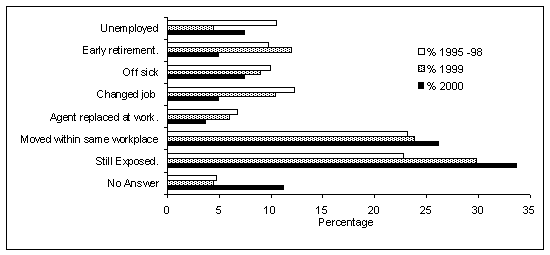Shield Report 2000; A Surveillance Scheme of Occupational Asthma in the Midlands |

|
V Huggins, W Anees, and PS Burge.
Occupational Lung Disease Unit, Heartlands Hospital, Bordesley Green East, Birmingham B9 5SS
SHIELD is the Midland Thoracic Society's Rare Respiratory Disease Registry Surveillance Scheme of Occupational Asthma for the West Midlands. The scheme, which was set up in January 1989, was established to study the general and specific incidence of occupational asthma within the West Midlands region and Metropolitan County. 80 reports have been received so far for 2000. The most common cause of occupational asthma in 2000 was isocyanates (19%) and has been for the last ten years. 77.5% of cases reported in 2000 were by the Birmingham Chest Clinic, and 22.5% by others, whereas in 1999, only 13 % of cases were being reported by other organisations which may suggest an increase in awareness of the scheme. The most common method for the diagnosis of occupational asthma still remains a history of improvement of symptoms during holidays or periods off work, with only 10% of cases having a specific bronchial challenge test.
Introduction
Shield is the Midland Thoracic Society's Rare Respiratory Disease Registry Surveillance Scheme of Occupational Asthma. The scheme, which was set up in January 1989, was established to meet three main objectives. 1) To study the general and specific incidence of occupational asthma within a defined geographic area, 2) To determine proposed mechanisms of asthma, and 3) to audit diagnostic methods and objectives. Chest physicians, the Medical Boarding Centre (respiratory disease), and members of the West Midlands Group of the Society of Occupational Medicine implemented the scheme, by reporting each new case using a questionnaire format. The questionnaire covers confidential personal information on the patient, details of the diagnosis, information about their occupational history, and the outcome after diagnosis.
The last report on Shields progress was written in 1999 and summarised the information gained in that year, to that of previous years1 1995-98 (as the last report before 1999 was in 1995). This report aims to update the participants of Shield by summarising the trends found in 2000 compared to those found in 1999 and 1995-98.
Outbreak of the year
You may have noticed that modern cars do not rust as badly as older cars previously produced. This is due to a new coating for metal car body parts known as "Zintec". Although this is an exciting new innovation for the car manufacturing industry, it has also presented some problems. 2000 has seen a surge in occupational asthma associated with zinc, which is thought to be due to the use of zintec. The zintec is welded, which is heating it to around 2000°C, and fumes from this are thought to be causing the problem.
Agent awareness of the year
The incidence of Latex induced occupational asthma has decreased in 2000 from 6 (6.74%) cases in 1999 to only 3 (3.75%) cases in 2000. There has been a steady decline in the number of reported cases of occupational asthma due to latex since 1997 when it was responsible for 8.1% of all reported cases that year. I am pleased to say that many hospitals are now aware of latex allergy and have replaced many items containing latex, the most obvious being surgical gloves, with alternatives. However, there is still a long way to go.
Shield data
Number of cases
The number of cases of occupational asthma reported to the Shield scheme is 80 so far. When the SHIELD report for 1999 was written, there were only 63 cases notified, but now this figure is up to 83, and is still rising. This means, that if we already have 80 reports for 2000, and the figure rises by the same percentage as 1999 has done, we could have well over 100 reports by mid 2002. This then suggests that the number of occupational asthma cases in the West midlands has risen since 1999. It is very difficult to compare notification for each year properly, therefore the graph below is only as a guideline, as the last few years are likely to change. The diamond shaped point is an estimate of how many notifications of occupational asthma there will be by mid 2002.
Figure 1 Number of cases diagnosed with occupational asthma between the years of 1980 and 2000.

Personal details
In the year of 2000, 80 new cases have been reported to the scheme so far. There were 56 males (70 %), and 24 females (30 %). 55 (69 %) of the new cases had no pre-existing asthma, and 29 (36 %) had never smoked.
Reporting hospital and physician
The Shield scheme is confined to the West midlands Region and the West Midlands Metropolitan County. In this region there are many chest physicians, hospitals, clinics and other organisations, which are known to the Shield scheme. However in the year of 2000, 62 (77.5 %) of the cases reported to Shield were through the Birmingham Chest Clinic, and only 18 (22.5 %) through other organisations. The percentage of cases being reported by the BCC each year (since 1995) has increased from 67.9 to 87% in 1999, but has fallen in 2000 to 77.5%. This shows that other organisations (a combination of 34 different ones), are becoming more involved again.
Suspected agents at work
In 2000 the reported agents that the workers were exposed to had varied from the previous years. The most common in 2000 and previous years (except 1997) was isocyanates. 274 cases of isocyanate suspected asthma have been reported to the scheme, the first case was in 1978. 14 cases of isocyanate asthma were reported in 2000 and 16 cases in 1999. The top ten primary agents reported in 2000 were; 1) Isocyanates (19%), 2) Glutaraldehyde (10%), 3) Zinc (8.8%), 4) Wood dusts (7.5%), 5 to 7) Oil mists, Colophony/solder flux and Chrome (6.3%), 8 & 9) Diesel Fumes and Unknown (5%), 10) Latex (3.8%). Most of these agents were in the top ten of 1999, however, flour and cobalt featured highly in 1999, whereas in 2000, there were no reports for cobalt, and only one for flour. On the other hand, Colophony was not in the top ten agents exposed in 1999, but was present between 1995 and 1998. Diesel fumes are relatively new, first appearing in the top ten agents in 1999.
Figure 3 Comparison of the percentage of patients exposed to the top ten agents in 2000 to those exposed in 1999 and 1995-98.

Employers and jobs
There were 66 different employers reported to the scheme in 2000, with 5 unknowns. Most of these employers were new to the scheme. The major outbreak for 2000 was at a car manufacturing plant using zintec. Some of these were diagnosed late in 1999 also. This particular outbreak accounts for 8.4% of all reports in 2000. In 1999 there were outbreaks in 2 factories. One of these was a car component manufacturer where people had become sensitised to cobalt. The other was also associated with cars, but there were a few different agents thought to be the cause.
57 different jobs were reported in 2000. The most common job was welding (6.25%) and 2.5% of jobs were unknown.
Table 1 A list of the most common agents reported in 2000 with the corresponding jobs
| Agent Exposed |
Job |
| Chrome |
Process operator, welder |
| Cleaning Agents |
Cleaner, laundry operator |
| Colophony |
Solderer, assembler |
| Coolant Oils |
Assembler, grinder, tool maker, tester |
| Diesel Fumes |
Tester, tyre fitter, coach builder |
| Epoxy Resins |
Plumber, violin maker |
| Glutaraldehyde |
Nurse (endoscopy and theatre), operating theatre assistant, healthcare assistant |
| Isocyanates |
Foundry core maker, servicer, storeman, fork lift truck driver, lacquerer, painter, primer, gluer/welder |
| Latex |
Midwife, nurse |
| Wood Dust |
Technology teacher, Joiner, labourer/driver |
| Zinc |
Welder, tool maker, jigger, engineer, moulder/diecaster, sheet metal worker |
Methods used for diagnosis
The methods used for the diagnosis of occupational asthma vary between each hospital and each physician. The methods that are documented on the shield form are; 1) Improvement on holiday, 2) Improvement off work, 3) Serial peak flow charts, 4) Specific IgE, 5) Methacholine at work, and 6) Methacholine away from work and 7) Bronchial provocation tests. 76 cases were documented as improving off work and on holidays. Of these 71, 55 cases had at least one other investigation. The most common investigation was serial peak flow charts (60 cases) followed by IgE (34 cases). There were 8 (9.6%) bronchial provocation tests in 2000, which is an increase from 7.5% in 1999.
Table 2 Percentage use of each method of diagnosing occupational asthma in 2000 and 1999.
| Method |
% 2000 |
% 1999 |
% 95-98 |
| Improving on holidays |
91.6 |
89.6 |
87.6 |
| Improving off work |
91.6 |
92.5 |
86.6 |
| Serial peak flow |
72.3 |
73.1 |
68.7 |
| Specific IgE |
41.0 |
56.7 |
47.5 |
| Methacholine at work |
26.5 |
26.9 |
15.7 |
| Methacholine away from work |
28.9 |
50.7 |
32.1 |
| Specific Bronchial Challenge |
9.6 |
7.5 |
7.8 |
Proposed method of ashtma
Figure 4 shows the proposed mechanism of asthma in patients with diagnosed occupational asthma in 2000 and 1999. In 2000 the most commonly reported mechanism of asthma was allergic 31 (38.7 %). In 1999 an allergic mechanism was also reported in most cases, however the overall percentage was more (56.7 %). The percentage of the cases where the mechanism is not known is higher in 2000 (40%) compared to the previous year (29.8 %), but the percentage of 'no answer' to the proposed mechanism for asthma has decreased in 2000 compared to last year. The other mechanisms (irritant and direct pharmacological effect) still remain low in the percentage of proposed mechanisms.
Figure 4 Proposed mechanisms of asthma in 2000, 1999 and 1995-98.

Subsequent History
The subsequent history of the patients diagnosed with occupational asthma in 2000 is very similar to that of 1999. Although a greater percentage of patients are still exposed to the agents at work or have received early retirement, there is a decrease in the percentage of unemployed and off sick. Relocation in the work place has increased and still remains the most popular solution. The percentage of 'no answer' has decreased from previous years. The recorded subsequent history of the patient is taken at diagnoses and may be changed as investigations occur, this means that the form should be updated and the true outcome for the patients diagnosed with occupational asthma in 2000 will not be seen until mid 2001.
Figure 5 Subsequent history of patients diagnosed of occ. asthma in 2000, 1999 and 1995-98.

Gold standards
A gold standard occupational asthma case is defined by either; 1) Bronchial challenge test, 2) A four fold change in their bronchial reactivity with a good history, or 3) Positive IgE with a good history, and all of theses can be accompanied by a good quality PEF record. 13.8% of cases in 2000 were gold standard which is slightly higher than 1999. However as gold standard is dependent upon the results of investigations it is likely that this will rise over the next year.
Future developments
This report has highlighted the problems in the Shield scheme to be a lack of reporting and a need for constant updating. The reduction in the number of reported cases is mainly due to the fatigue and lack of awareness of the scheme. However reporting from the region has increased following the new rare disease form. Also the number of 'no answers' to questions implies that the results of further investigations are not being reported. To try and solve the above problems we believe that a follow-up questionnaire will help. The initial questionnaire will be sent as it now, but once this is received a copy will be sent back with the reported details. Included on the printed sheet will be an advised 2nd reporting date. This will enable the physician to complete the form as and when the investigations are carried out, and to send the form back when completed or by the 2nd reporting date. Using this method it will be clear in the notes if the patient has been reported, at what stage the investigations are at whilst maintaining an up to date database.
Comments
Please sign in or register to add your thoughts.